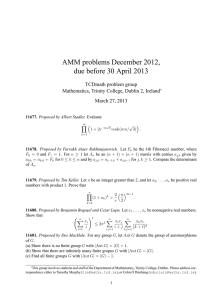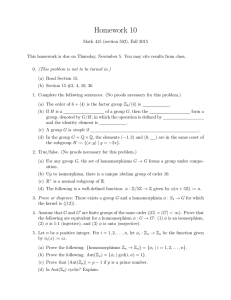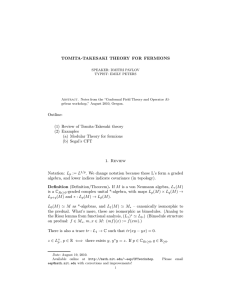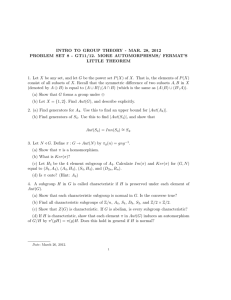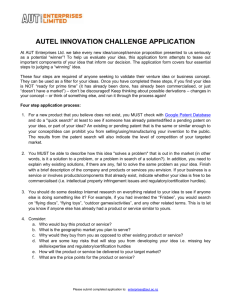Math 322: Problem Set 8 (due 6/11/2015) 1.
advertisement
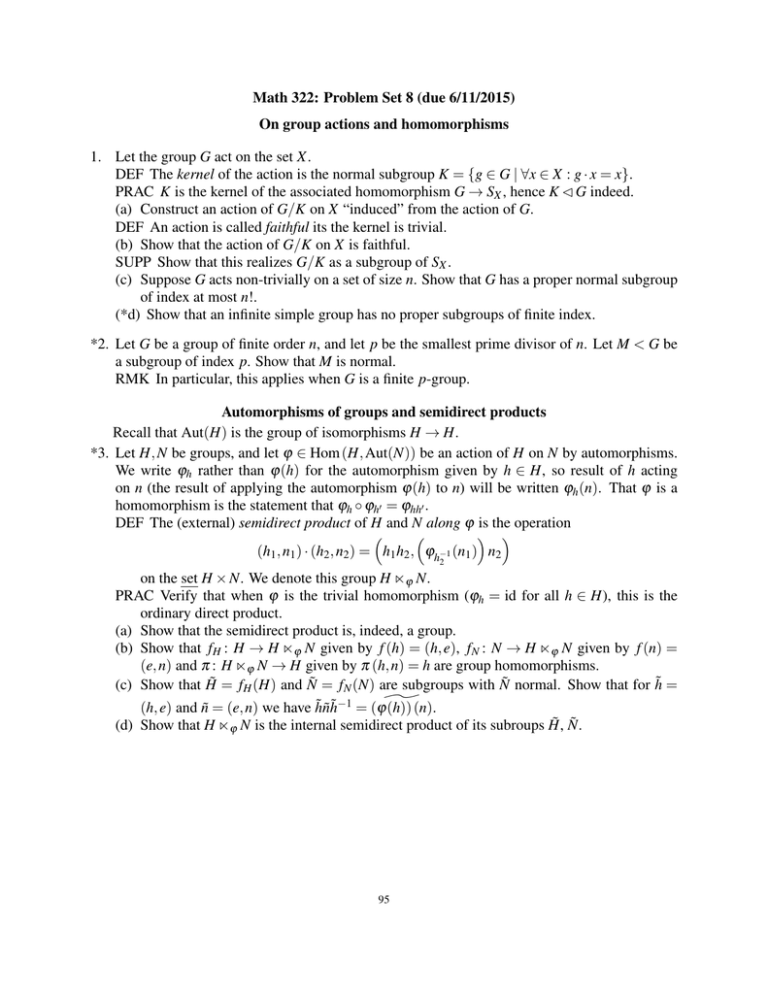
Math 322: Problem Set 8 (due 6/11/2015)
On group actions and homomorphisms
1. Let the group G act on the set X.
DEF The kernel of the action is the normal subgroup K = {g ∈ G | ∀x ∈ X : g · x = x}.
PRAC K is the kernel of the associated homomorphism G → SX , hence K C G indeed.
(a) Construct an action of G/K on X “induced” from the action of G.
DEF An action is called faithful its the kernel is trivial.
(b) Show that the action of G/K on X is faithful.
SUPP Show that this realizes G/K as a subgroup of SX .
(c) Suppose G acts non-trivially on a set of size n. Show that G has a proper normal subgroup
of index at most n!.
(*d) Show that an infinite simple group has no proper subgroups of finite index.
*2. Let G be a group of finite order n, and let p be the smallest prime divisor of n. Let M < G be
a subgroup of index p. Show that M is normal.
RMK In particular, this applies when G is a finite p-group.
Automorphisms of groups and semidirect products
Recall that Aut(H) is the group of isomorphisms H → H.
*3. Let H, N be groups, and let ϕ ∈ Hom (H, Aut(N)) be an action of H on N by automorphisms.
We write ϕh rather than ϕ(h) for the automorphism given by h ∈ H, so result of h acting
on n (the result of applying the automorphism ϕ(h) to n) will be written ϕh (n). That ϕ is a
homomorphism is the statement that ϕh ◦ ϕh0 = ϕhh0 .
DEF The (external) semidirect product of H and N along ϕ is the operation
(h1 , n1 ) · (h2 , n2 ) = h1 h2 , ϕh−1 (n1 ) n2
2
on the set H × N. We denote this group H nϕ N.
PRAC Verify that when ϕ is the trivial homomorphism (ϕh = id for all h ∈ H), this is the
ordinary direct product.
(a) Show that the semidirect product is, indeed, a group.
(b) Show that fH : H → H nϕ N given by f (h) = (h, e), fN : N → H nϕ N given by f (n) =
(e, n) and π : H nϕ N → H given by π (h, n) = h are group homomorphisms.
(c) Show that H̃ = fH (H) and Ñ = fN (N) are subgroups with Ñ normal. Show that for h̃ =
^(n).
(h, e) and ñ = (e, n) we have h̃ñh̃−1 = (ϕ(h))
(d) Show that H nϕ N is the internal semidirect product of its subroups H̃, Ñ.
95
4. (Concrete 3(b),(c),(d)) Let H = R× act on N=R
by multiplication (so ϕh (n) = hn). Show
h n
H nϕ N is isomorphic to the subgroup P =
| h ∈ R× , n ∈ R of GL2 (R).
1
SUPP Do the same with H = (Z/nZ)× , N = Z/nZ. Now
P is a finite group. h n
SUPP Same with H = GLd (R), N = Rd , P =
| h ∈ GLd (R), n ∈ Rd < GLd+1 (R).
1
5. (Cylic groups)
(a) Let A be a group. Show that mapping f ∈ Hom(Cn , A) to f ([1]n ) gives a bijection between
Hom(Cn , A) and the set of a ∈ A of order dividing n.
(b) Write fa for the homomorphism such that f ([1]) = a. When A = Cn = (Z/nZ, +) show
that fa ◦ fb = fab (ab is multiplication mod n) and hence that Aut(Cn ) ' (Z/nZ)× .
RMK You’ve just done a fancy version of problem 4 of PS1
Bonus problem
6. The two parts complete problem 3. For these let ϕ ∈ Hom(H, Aut(N)).
(a) For α ∈ Aut(H) define ψ : H → Aut(N) by ψ = ϕ ◦ α (that is ψh = ϕα(h) ). Show that
F (h, n) = α −1 (h), n gives an isomorphism F : H nϕ N → H nψ N.
(b) For β ∈ Aut(N) define ψ : H → Aut(N) by ψh = β ◦ ϕh ◦ β −1 (this is conjugation in
Aut(N)!). Show that H nϕ N ' H nψ N.
(c) Let a, b ∈ Aut(N) generate the same cyclic subgroup, and let fa , fb ∈ Hom(Cn , Aut(N)) be
the maps from 5(b). Show that Cn n fa N ' Cn n fb N
RMK From (b),(c) we conclude and conclude that semidirect products Cn n N are determined
by conjugacy classes of subgroups of Aut(N) of order dividing n.
96
Supplementary problems
A. We show that (Z/pZ)× ' C p−1 so that Aut(C p ) ' C p−1 .
(a) Let F be a field. Show that F × has at most d elements of order dividing d (hint: a
polynomial of degree d over a field has at most d roots).
(b) Let H < F × be a finite group. Show that H is cyclic.
(c) Show that Aut(C p ) ' C p−1 .
Solving the following problem involves many parts of the course.
B. Let G be a group of order 8.
(a) Suppose G is commutative. Show that G is isomorphic to one of C8 , C4 ×C2 , C2 ×C2 ×C2 .
(b) Suppose G is non-commutative. Show that there is a ∈ G of order 4 and let H = hai.
(c) Show that a ∈
/ Z(G) but a2 ∈ Z(G).
(d) Suppose there is b ∈ G − H of order 2. Show that G ' D8 (hint: bab−1 ∈ a, a3 but can’t
be a).
(e) Let b ∈ G − H have order 4. Show that bab−1 = a3 and that a2 = b2 = (ab)2 .
(f) Setting c = ab, −1 = a2 and −g = (−1)g show that G = {±1, ±a, ±b, ±c}with the multiplication rule ab = c, ba = −c, bc = a, cb = −a, ca = b, ac = −b.
(g) Show that the set in (f) with the indicated operation is indeed a group.
DEF The group of (f),(g) is called the quaternions and indicated by Q.
C. Let G be a group (especially infinite).
DEF Let X be a set. A chain C ⊂ P(X) is a set of subsets of X such that if A, B ∈ C then either
A ⊂ B or B ⊂ A.
(a) Show that if C is a chain then for every finite subset {Ai }ni=1 ⊂ C there is B ∈ C such that
Ai ⊂ B for all i.
S
(b) Suppose C is a non-empty chain of subgroups of a group G. Show that the union C is a
subgroup of G containing all A ∈ cC.
S
(c) Suppose C is a chain of p-subgroups of G. Show that C is a p-group as well.
(*d) Use Zorn’s Lemma to show that every group has maximal p-subgroups (p-subgroups
which are not properly contained in other p-subgrounps), in fact that every p-subgroup is
contained in a maximal one.
RMK When G is infinite, it does not follow that these maximal subgroups are all conjugate.
97
